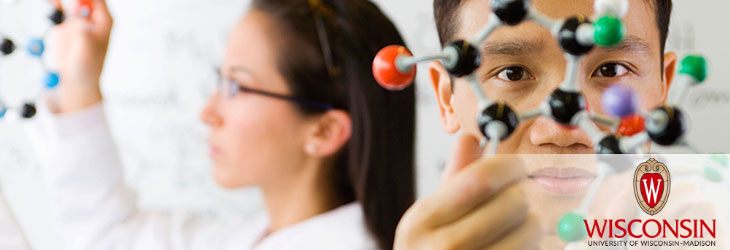Drug Discovery & Development

Research Tool for Protein Conformation Analysis
WARF: P160180US02
Inventors: Michael Sussman, J. Leon Shohet, Faraz Choudhury, Joshua Blatz, Benjamin Minkoff, Daniel Benjamin
The Wisconsin Alumni Research Foundation (WARF) is working with UW–Madison researchers to develop a powerful new method that combines plasma-induced oxidation, followed by mass spectrometry, to study the 3-D conformation and solvent accessibility of biological molecules.
Overview
The three-dimensional structure of proteins can be studied in solution using various methods of covalent and noncovalent labeling in which the readout is accomplished by mass spectrometry (MS). These procedures, collectively known as protein ‘footprinting,’ all involve measuring the solvent accessibility of either the peptide backbone (hydrogen deuterium exchange) or amino acid side chains (covalent modification and cross linking reagents). After labeling, proteins are analyzed using tandem MS and linkages or adducts are quantitatively mapped to specific regions, revealing areas and degrees of intermolecular interactions or solvent accessibility.
The emergence of the quickly expanding protein therapeutics industry has generated a need for easy, sensitive and reproducible methods for detecting changes in protein conformation as part of the rigorous quality control process required for clinical use and for quickly detecting the regions of proteins involved in their binding to ligands and/or protein-protein interactions.
The emergence of the quickly expanding protein therapeutics industry has generated a need for easy, sensitive and reproducible methods for detecting changes in protein conformation as part of the rigorous quality control process required for clinical use and for quickly detecting the regions of proteins involved in their binding to ligands and/or protein-protein interactions.
The Invention
UW–Madison researchers have developed a method and easy-to-operate device that uses plasma to perform hydroxyl radical footprinting. The device tags the outer surface of the protein and allows the user to study its 3-D conformation via mass spectrometry.
The new technique, which is workable on a benchtop, applicable to a range of protein concentrations and sizes and generates µs bursts of hydroxyl radicals without added chemicals or reagents, has been developed and the results benchmarked. It is useful for quickly performing epitope mapping or assessing protein structural characteristics such as unfolding and conformational changes. The method can be used with two or more distinct proteins to map binding events, which enables pharmaceutical and R&D labs to image proteins in their natural state.
The researchers believe this tool will enable much quicker turnaround (on the order of hours) than X-ray crystallography and more reliable data than Hydrogen-Deuterium Exchange (HDX). It can be manufactured alone or in conjunction with mass spectrometry systems.
The new technique, which is workable on a benchtop, applicable to a range of protein concentrations and sizes and generates µs bursts of hydroxyl radicals without added chemicals or reagents, has been developed and the results benchmarked. It is useful for quickly performing epitope mapping or assessing protein structural characteristics such as unfolding and conformational changes. The method can be used with two or more distinct proteins to map binding events, which enables pharmaceutical and R&D labs to image proteins in their natural state.
The researchers believe this tool will enable much quicker turnaround (on the order of hours) than X-ray crystallography and more reliable data than Hydrogen-Deuterium Exchange (HDX). It can be manufactured alone or in conjunction with mass spectrometry systems.
Applications
- Assessing the 3-D conformation of proteins, nucleic acids and other biological molecules
- Determining solvent accessibility of different parts of the protein
- Study of condition-dependent sample properties (e.g., kinetics, protein folding)
Key Benefits
- Demonstrated dose-dependent and reproducible results
- Unique device design and method
- Shown to work quickly and efficiently
- Simple to operate and relatively inexpensive to produce
- No exogenous materials need to be added to the sample solution.
- Users can test various conditions of interest without artifacts.
Stage of Development
The new technique was first benchmarked with model compounds, and then applied to a biological problem, i.e., ligand (EGF) induced changes in the conformation of the external (ecto) domain of Epidermal Growth Factor Receptor (EGFR). Regions in which oxidation decreased upon adding EGF fall along the dimerization interface, consistent with models derived from crystal structures. These results demonstrate that plasma-generated hydroxyl radicals from water can be used to map protein conformational changes, and provide a readily accessible means of studying protein structure in solution.
Future experiments will explore optimization and further biological applications. The researchers envision optional modifications to the apparatus to allow adjustments to the frequency, pulse width and number, voltage and timing of the pulses. Such adjustments would enhance the flexibility of this powerful analytical technology.
Future experiments will explore optimization and further biological applications. The researchers envision optional modifications to the apparatus to allow adjustments to the frequency, pulse width and number, voltage and timing of the pulses. Such adjustments would enhance the flexibility of this powerful analytical technology.
Additional Information
For More Information About the Inventors
Tech Fields
For current licensing status, please contact Jennifer Gottwald at [javascript protected email address] or 608-960-9854